Radishrain
Things pertaining to life: plants and animals, gardening, cooking, food, botany, zoology, farming, ranching, wildlife, genetics, plant breeding, software, media, etc.
Here's a recipe I used, which I liked (it tastes awesome and is great on burritos in place of salsa):
~1 gallon of blended up raw peppers (mostly Jalapenos); I added a little filtered water to help blend them (but you might want to use some of the vinegar below instead)
3 cups of distilled white vinegar
4 to 6 tablespoons of pickling salt (6 might be too much for it to ferment properly, but I don't remember how much I used)
Some cardamom (I didn't measure)
Stir everything together and boil it for 20 to 40 minutes (my peppers were old—that's why I cooked them, and that's partially why added vinegar and probiotics). Let it cool until it's warm enough for probiotics to live (I just waited until it was cool enough not to hurt when I held the pot). Add a probiotic starter (since it's been boiled and doesn't have natural ones). I added about 3 billion organisms per quart, and there were three quarts at this point (the probiotics were in the form of chewable probiotic wafers containing L. acidophilus and B. lactis).
Put in jars and ferment. I put a tight lid on it with a silicone seal, without an airlock, and just watched (felt the lid for pressure) it to see if it needed burping. It didn't need it very often (my hypothesis is that it's because of acetic acid bacteria in the vinegar), if at all, actually, but eventually, the sauce fermented (the sauce in the cooler location took a lot longer than the one in a warmer location). If you open the lid to taste it, be sure to stir it before you put the lid back on.
The warmer jar tasted fermented after about seven days, but it tasted a lot better the day after I first tasted it (after I opened the jar; opening the jar at some point to taste and stir it seems to encourage faster fermentation).
recipe_
pepper_
ferment_
vinegar_
cardamom_
~1 gallon of blended up raw peppers (mostly Jalapenos); I added a little filtered water to help blend them (but you might want to use some of the vinegar below instead)
3 cups of distilled white vinegar
4 to 6 tablespoons of pickling salt (6 might be too much for it to ferment properly, but I don't remember how much I used)
Some cardamom (I didn't measure)
Stir everything together and boil it for 20 to 40 minutes (my peppers were old—that's why I cooked them, and that's partially why added vinegar and probiotics). Let it cool until it's warm enough for probiotics to live (I just waited until it was cool enough not to hurt when I held the pot). Add a probiotic starter (since it's been boiled and doesn't have natural ones). I added about 3 billion organisms per quart, and there were three quarts at this point (the probiotics were in the form of chewable probiotic wafers containing L. acidophilus and B. lactis).
Put in jars and ferment. I put a tight lid on it with a silicone seal, without an airlock, and just watched (felt the lid for pressure) it to see if it needed burping. It didn't need it very often (my hypothesis is that it's because of acetic acid bacteria in the vinegar), if at all, actually, but eventually, the sauce fermented (the sauce in the cooler location took a lot longer than the one in a warmer location). If you open the lid to taste it, be sure to stir it before you put the lid back on.
The warmer jar tasted fermented after about seven days, but it tasted a lot better the day after I first tasted it (after I opened the jar; opening the jar at some point to taste and stir it seems to encourage faster fermentation).
recipe_
pepper_
ferment_
vinegar_
cardamom_
My mom makes very frittata-like omelets. We call them omelets, anyhow. I decided to try to make one today, for the first time. I don't know exactly how she does it, but I guessed to fill in the gaps, and I think I'm right, because it turned out well. Yes, I used ingredients my mom wouldn't have, however.
Here's what I did:
* I put avocado oil, seven eggs, chives, and a sliced Farmer's Jalapeno, in an eight-inch Lodge cast-iron skillet.
* I cut up some tomatoes and cheddar cheese
* I put the oven on broil (high).
* I started cooking the eggs on the stovetop
* I added Gel brand fajita seasoning to the eggs
* When the eggs were mostly cooked, I put wonderberries and the tomatoes on top, and the cheese on top of everything else.
* I put the pan in the oven (not right at the top, but closer to the top than the bottom) to broil until the cheese was good and cooked.
* I let it sit for a bit.
* I ate it.
It tasted excellent. I highly recommend it, especially with my Brandy Boy cross F2 tomatoes.
frittata_
recipe_
tomato_
cheese_
chives_
pepper_
egg_
chicken_
Here's what I did:
* I put avocado oil, seven eggs, chives, and a sliced Farmer's Jalapeno, in an eight-inch Lodge cast-iron skillet.
* I cut up some tomatoes and cheddar cheese
* I put the oven on broil (high).
* I started cooking the eggs on the stovetop
* I added Gel brand fajita seasoning to the eggs
* When the eggs were mostly cooked, I put wonderberries and the tomatoes on top, and the cheese on top of everything else.
* I put the pan in the oven (not right at the top, but closer to the top than the bottom) to broil until the cheese was good and cooked.
* I let it sit for a bit.
* I ate it.
It tasted excellent. I highly recommend it, especially with my Brandy Boy cross F2 tomatoes.
frittata_
recipe_
tomato_
cheese_
chives_
pepper_
egg_
chicken_
The turban melon split open, probably a while ago by the look of it. I started fermenting the seeds and used the rest to enrich soil, since it seemed unsafe to eat. I'm fermenting the seeds since they have a whole lot of gel. Since that trait seems recessive my plant probably isn't a cross (unless it crossed with Kirkman). I'm not sure that the flesh is as white this year, though.
Many of the seeds, especially at the stem end, were not the usual shape. The turban part was chalk full of seeds.
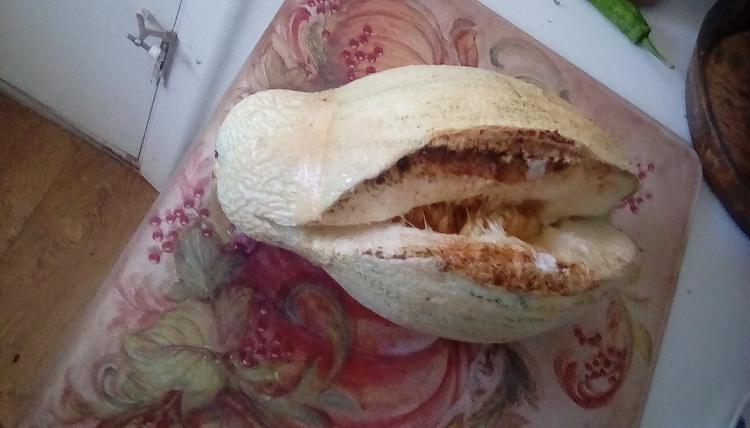
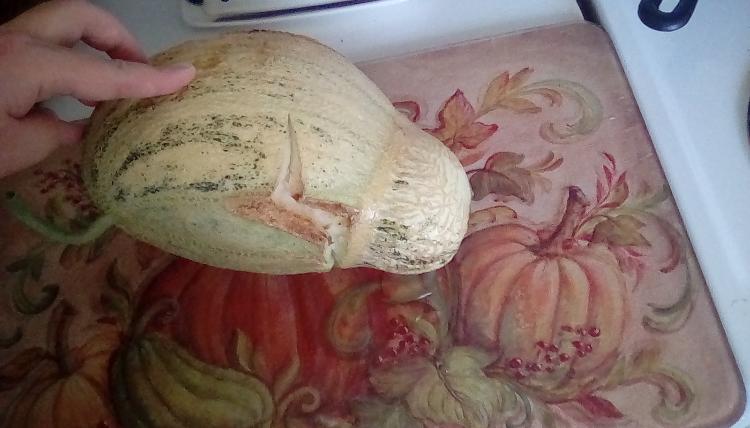
Many of the seeds, especially at the stem end, were not the usual shape. The turban part was chalk full of seeds.


Here's a picture of our largest watermelon to date, this season (I'm guessing it's 17lbs; there are some potential contenders). It's not huge, but it's large for our garden. It has pink flesh and black seeds. It may, or may not, have a winter watermelon in its ancestry.
This was one of the first ripe watermelons, this season. I had it in the refrigerator for a while. It was good, but not super sweet or anything. A little under-sweet, but definitely still good. It may have had more flavor and sugar if grown in another spot, I'm guessing. It's near where the Coldset tomato was last year (which didn't have a lot of flavor there, either, although the fruits got large and nice).
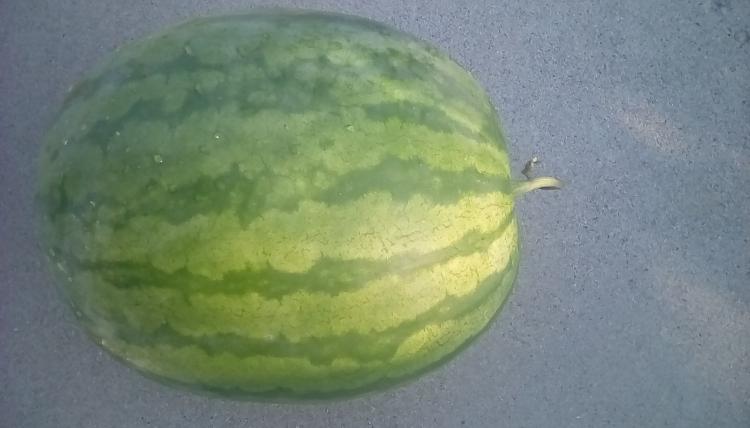
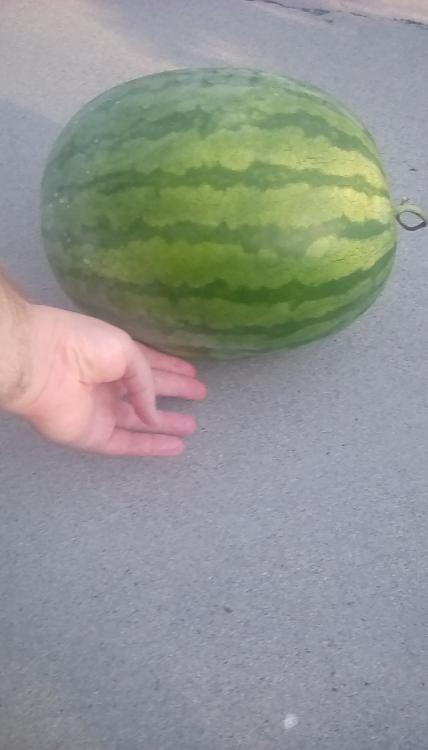
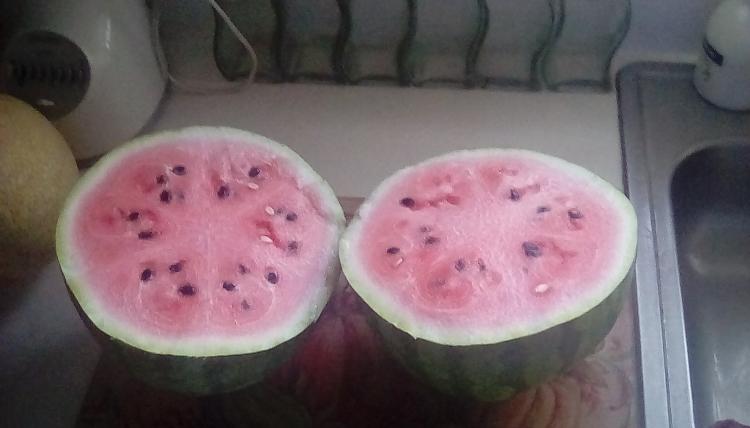
This was one of the first ripe watermelons, this season. I had it in the refrigerator for a while. It was good, but not super sweet or anything. A little under-sweet, but definitely still good. It may have had more flavor and sugar if grown in another spot, I'm guessing. It's near where the Coldset tomato was last year (which didn't have a lot of flavor there, either, although the fruits got large and nice).



I grew Honeycomb F1 last year and saved the seeds (at least one of which got cross-pollinated by Torpeda). I grew the cross-pollinated seed this year, and it grew these two fine fruits, which were quite striped earlier in the season. They slipped from the vine when ripe, surprisingly. I don't recall either of the parents doing that.
Anyway, it has a very small seed cavity! I'm impressed. It has the watermelon-like texture that Torpeda had, except somewhat softer. The flavor is very intense and rich. It's one of the best melons I've ever had! Extremely sweet, too. I like how many of the seeds don't have lots of gel (some of them do). The stripes are dominant. The flesh texture is dominant. Honeycomb's flesh color seems dominant (Torpeda was coconut white).
The one I cut open and tasted was the smaller of the two (I had just eaten a lot of watermelon). I put the bigger one in the refrigerator.
The fruits are maybe about six inches long. Maybe 4-7lbs or so.
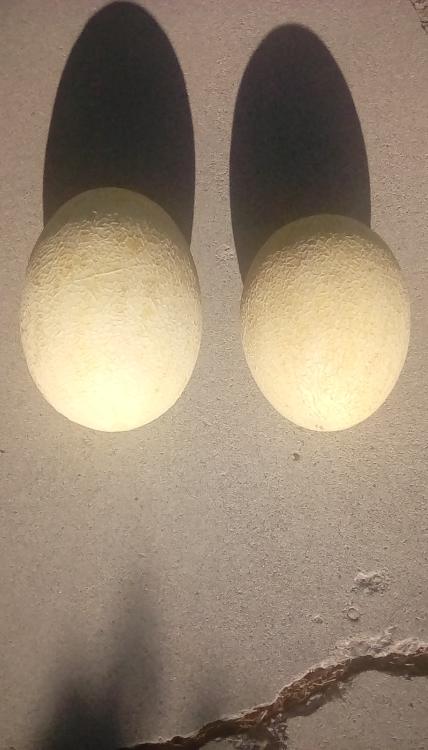
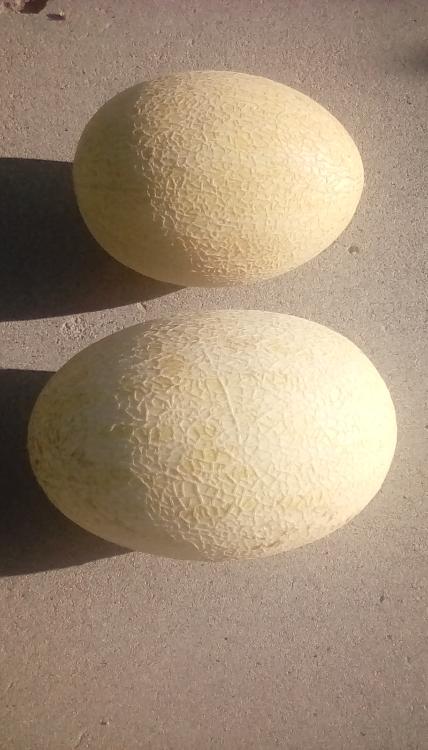
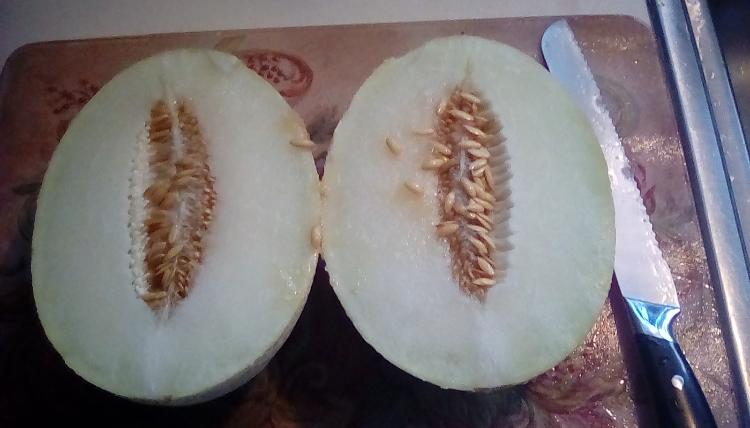
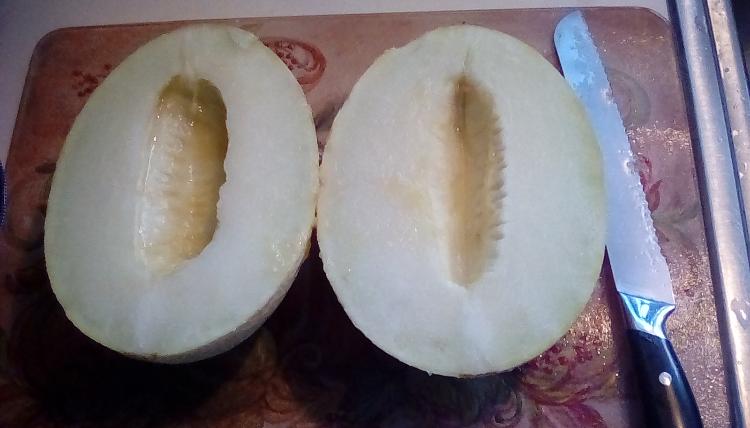
Anyway, it has a very small seed cavity! I'm impressed. It has the watermelon-like texture that Torpeda had, except somewhat softer. The flavor is very intense and rich. It's one of the best melons I've ever had! Extremely sweet, too. I like how many of the seeds don't have lots of gel (some of them do). The stripes are dominant. The flesh texture is dominant. Honeycomb's flesh color seems dominant (Torpeda was coconut white).
The one I cut open and tasted was the smaller of the two (I had just eaten a lot of watermelon). I put the bigger one in the refrigerator.
The fruits are maybe about six inches long. Maybe 4-7lbs or so.




I grew Matina in 2016 (from seeds from timeless-tomatoes.com), 2017 (from seeds saved in 2016), and 2019 (from seeds from timeless-tomatoes.com).
In 2016, the plant was watered a lot. It was very early and prolific. Many people favored this tomato. It was mildly tangy. The plant was caged. It was vigorous and large. This, along with Thessaloniki, was a favorite.
In 2017, the plants were not watered much at all. They didn't produce many fruits; those they did produce were extremely flavorful (some might say too flavorful to the point of tasting burned). The plants were vigorous and large. The fruit was early.
In 2019, I didn't use saved seeds for fear of last year's being a cross, due to the low production. They tasted pretty normal, maybe similar to how Early Girl F1 does this year. The plant is caged, this year. The plant is unusual in that it produced lots of branches faster than other Matina plants might. It first got at least seven ripe fruits at once (rather than one or two). It wasn't early. The plant received little water and was grown with black plastic around it.
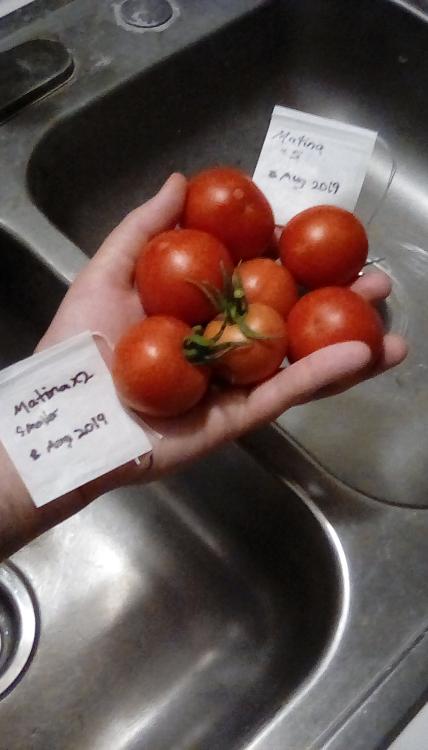
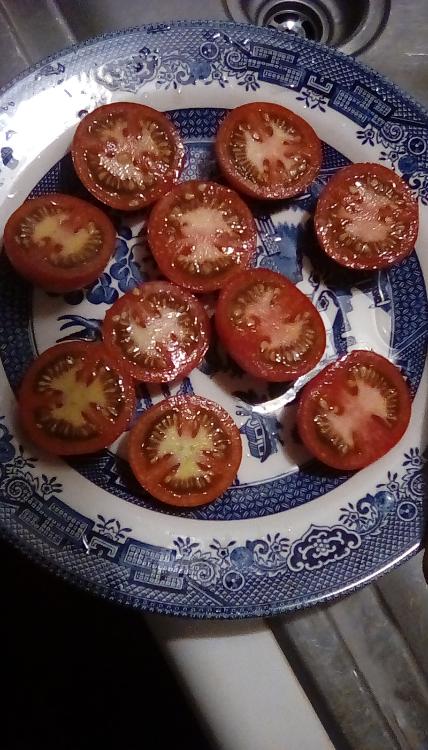
heirloom_tomato
In 2016, the plant was watered a lot. It was very early and prolific. Many people favored this tomato. It was mildly tangy. The plant was caged. It was vigorous and large. This, along with Thessaloniki, was a favorite.
In 2017, the plants were not watered much at all. They didn't produce many fruits; those they did produce were extremely flavorful (some might say too flavorful to the point of tasting burned). The plants were vigorous and large. The fruit was early.
In 2019, I didn't use saved seeds for fear of last year's being a cross, due to the low production. They tasted pretty normal, maybe similar to how Early Girl F1 does this year. The plant is caged, this year. The plant is unusual in that it produced lots of branches faster than other Matina plants might. It first got at least seven ripe fruits at once (rather than one or two). It wasn't early. The plant received little water and was grown with black plastic around it.


heirloom_tomato
I've been growing Mountain Princess every year since 2016 (from seeds freshly saved the previous year each year, except 2016, when I used seeds from timeless-tomatoes.com).
Anyway, this year, the fruit is about as large as it was in 2016 (when it was watered heavily, although this year it was not watered much, but it was the first time I used black plastic with it). It was somewhat smaller in 2017 and 2018, but tastier than on 2016 and 2019, too. It's later this year than any year previous. It had a sweet aftertaste/smell in 2016 that I didn't taste in other years. The fruits were softer in 2017 and 2018.
The plants this year did receive wood ash.
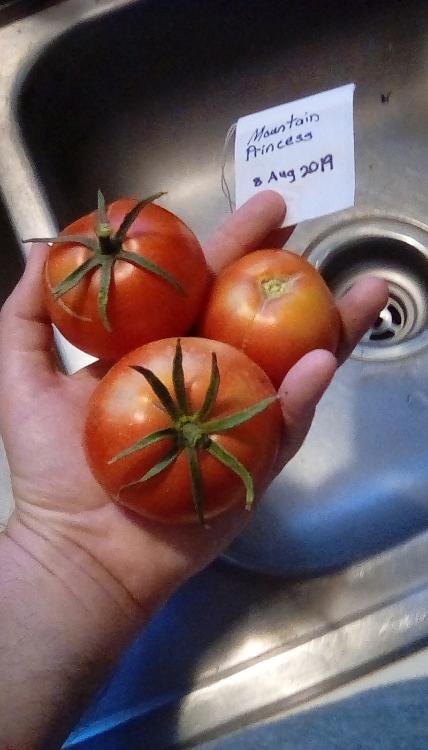
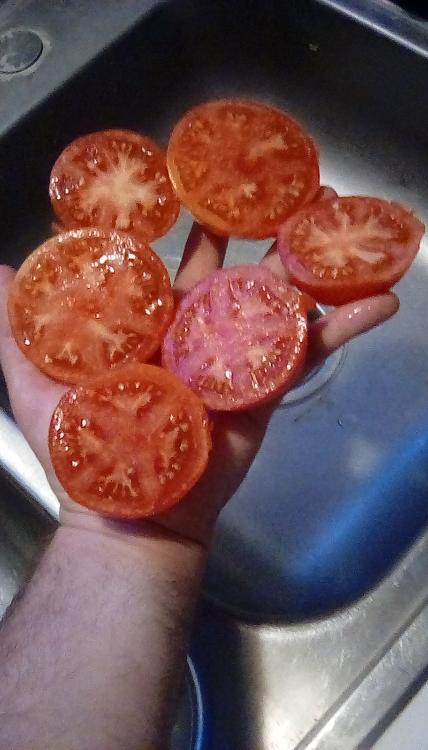
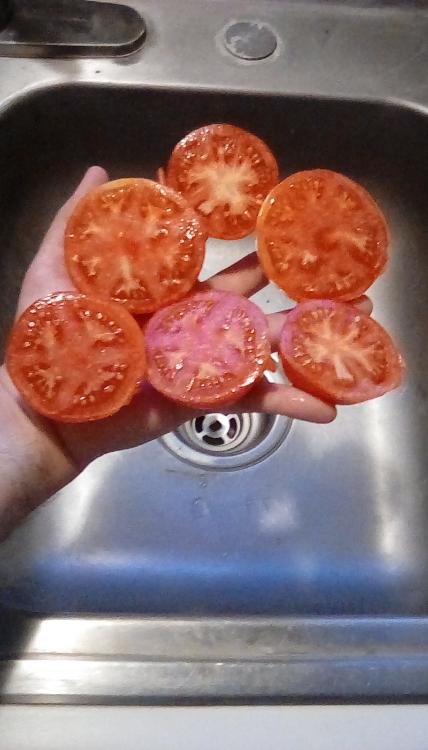
heirloom_tomato
Anyway, this year, the fruit is about as large as it was in 2016 (when it was watered heavily, although this year it was not watered much, but it was the first time I used black plastic with it). It was somewhat smaller in 2017 and 2018, but tastier than on 2016 and 2019, too. It's later this year than any year previous. It had a sweet aftertaste/smell in 2016 that I didn't taste in other years. The fruits were softer in 2017 and 2018.
The plants this year did receive wood ash.



heirloom_tomato
So, I found some Epazote seeds at tradewindsfruit.com and grew a plant, this year. It took a while to get started, but wow! It really seems to make beans feel nutritious (normally, beans don't make me feel extremely nourished, but I tried some black beans and ham with epazote and Mexican sour cream on spinach-flavored green tortillas, today, and yeah, it worked). The flavor is quite good with beans, too, in my opinion.
Epazote is supposed to reduce flatulence that comes from eating beans, too; I don't have experience there one way or the other to tell you how it works in that regard.
I hope seed-saving is easy for epazote. I want to grow it every year.
Epazote is supposed to reduce flatulence that comes from eating beans, too; I don't have experience there one way or the other to tell you how it works in that regard.
I hope seed-saving is easy for epazote. I want to grow it every year.
Those who grow wonderberries might appreciate this (religious) video, entitled Flecks of Gold, at harvest time: https://youtu.be/fEfg-Z-TOc8
"The patient accumulation of these little flecks has brought me great wealth."
I spent about an hour or so harvesting all our ripe wonderberries, today. There should be even more in a few days. I felt pretty rewarded.
There are more wonderberries in the containers than the picture seems to show (the bowl is maybe two thirds of the way full). It's enough for a cobbler, or almost enough for a reasonably-sized pie, I'd say. I might settle on tarts.
I ate my fill before I started filling the bowl. I'm grateful I have so many wonderberry plants! They're awesome, and discovered/remembered that they actually can get sweeter than I previously told. I easily enjoy eating them as much as any other berry.
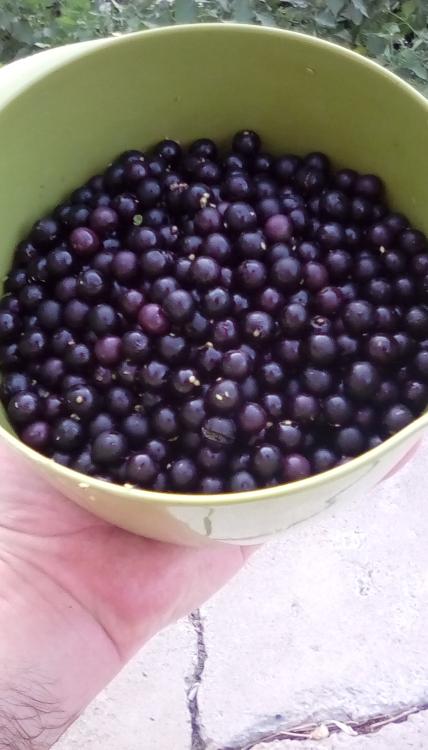
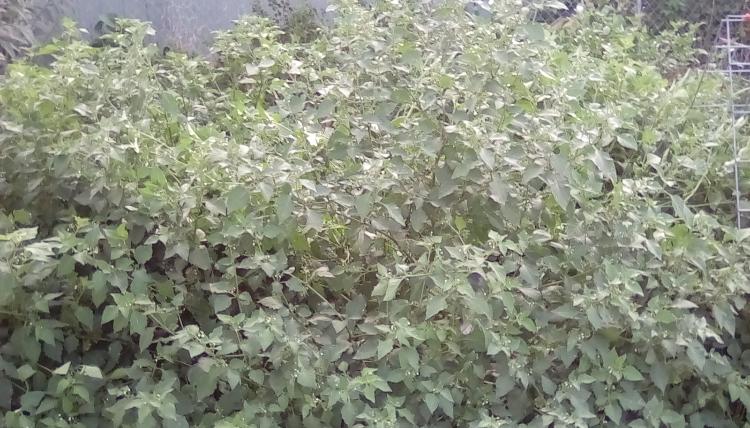
religious_
video_
"The patient accumulation of these little flecks has brought me great wealth."
I spent about an hour or so harvesting all our ripe wonderberries, today. There should be even more in a few days. I felt pretty rewarded.
There are more wonderberries in the containers than the picture seems to show (the bowl is maybe two thirds of the way full). It's enough for a cobbler, or almost enough for a reasonably-sized pie, I'd say. I might settle on tarts.
I ate my fill before I started filling the bowl. I'm grateful I have so many wonderberry plants! They're awesome, and discovered/remembered that they actually can get sweeter than I previously told. I easily enjoy eating them as much as any other berry.


religious_
video_
I'm growing seeds that I was told were Charley's Pride. However the fruits didn't match the description—but I think that may just be because the plants are struggling with the growing conditions. The fruits are undersized, and not all of them are striped. They should be quite large and striped.
Whatever variety it is, though, the taste is phenomenal! It's one of the sweetest melons I've tasted, which is really saying something for an undersized melon. It's super sweet and really good. It's almost a bubble gum type flavor, but it's not (it tastes very much like very good food).
The fruit smelled good before I cut it open, but it smelled much better after I cut it open. The flesh is orange (it looks less orange in the picture).
Next year, I plan to overwinter some seeds in a spot amended with basalt rockdust, potassium and phosphorus. That should help it do better, as should some acclimatization.
Here are some pictures of the first ripe one of them:
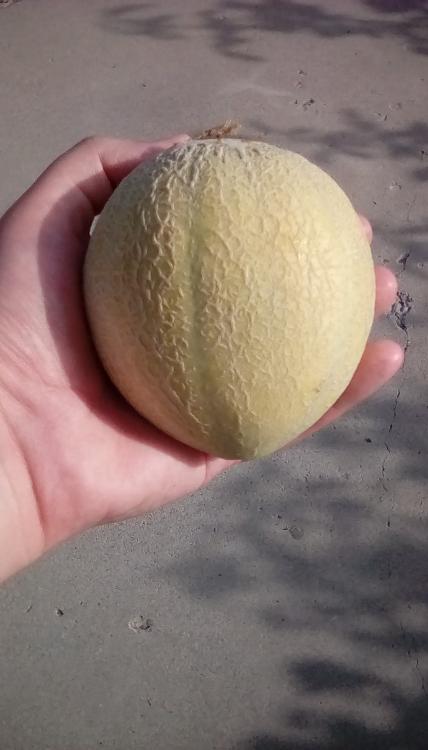
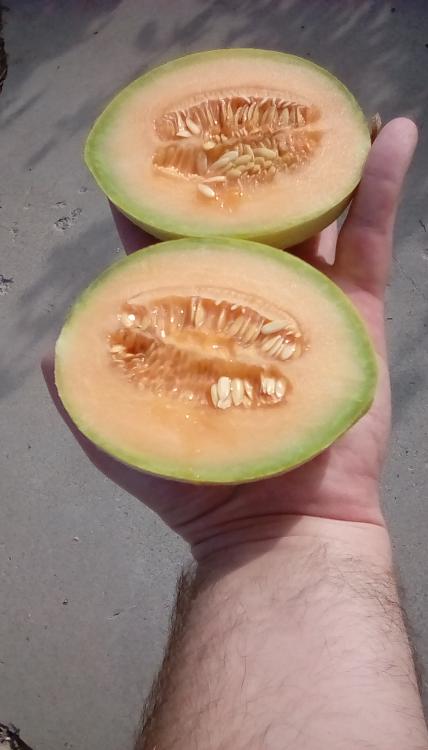
Whatever variety it is, though, the taste is phenomenal! It's one of the sweetest melons I've tasted, which is really saying something for an undersized melon. It's super sweet and really good. It's almost a bubble gum type flavor, but it's not (it tastes very much like very good food).
The fruit smelled good before I cut it open, but it smelled much better after I cut it open. The flesh is orange (it looks less orange in the picture).
Next year, I plan to overwinter some seeds in a spot amended with basalt rockdust, potassium and phosphorus. That should help it do better, as should some acclimatization.
Here are some pictures of the first ripe one of them:


Subscribe via email
Archives
| Free forum by Nabble | Edit this page |


